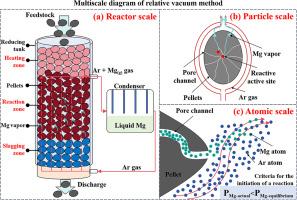当前位置:
X-MOL 学术
›
J. Magnes. Alloys
›
论文详情
Our official English website, www.x-mol.net, welcomes your
feedback! (Note: you will need to create a separate account there.)
Relative vacuum reduction innovative processes applied in primary magnesium production—Comprehensive analysis of thermodynamics, resource, energy flow, and carbon emission
Journal of Magnesium and Alloys ( IF 15.8 ) Pub Date : 2024-09-05 , DOI: 10.1016/j.jma.2024.06.027 Xiaolong Li, Tingan Zhang, Yan Liu, Junhua Guo, Jingzhong Xu, Yuanyuan Liang
Journal of Magnesium and Alloys ( IF 15.8 ) Pub Date : 2024-09-05 , DOI: 10.1016/j.jma.2024.06.027 Xiaolong Li, Tingan Zhang, Yan Liu, Junhua Guo, Jingzhong Xu, Yuanyuan Liang

|
Magnesium and magnesium alloys, serving as crucial lightweight structural materials and hydrogen storage elements, find extensive applications in space technology, aviation, automotive, and magnesium-based hydrogen industries. The global production of primary magnesium has reached approximately 1.2 million tons per year, with anticipated diversification in future applications and significant market demand. Nevertheless, approximately 80 % of the world's primary magnesium is still manufactured through the Pidgeon process, grappling with formidable issues including high energy consumption, massive carbon emission, significant resource depletion, and environmental pollution. The implementation of the relative vacuum method shows potential in breaking through technological challenges in the Pidgeon process, facilitating clean, low-carbon continuous magnesium smelting. This paper begins by introducing the principles of the relative vacuum method. Subsequently, it elucidates various innovative process routes, including relative vacuum ferrosilicon reduction, aluminum thermal reduction co-production of spinel, and aluminum thermal reduction co-production of calcium aluminate. Finally, and thermodynamic foundations of the relative vacuum, a quantitative analysis of the material, energy flows, carbon emission, and production cost for several new processes is conducted, comparing and analyzing them against the Pidgeon process. The study findings reveal that, with identical raw materials, the relative vacuum silicon thermal reduction process significantly decreases raw material consumption, energy consumption, and carbon dioxide emissions by 15.86%, 30.89%, and 26.27%, respectively, compared to the Pidgeon process. The relative vacuum process, using magnesite as the raw material and aluminum as the reducing agent, has the lowest magnesium-to-feed ratio, at only 3.385. Additionally, its energy consumption and carbon dioxide emissions are the lowest, at 1.817 tce/t Mg and 7.782 t CO2/t Mg, respectively. The energy consumption and carbon emissions of the relative vacuum magnesium smelting process co-producing calcium aluminate (12CaO·7Al2O3, 3CaO·Al2O3, and CaO·Al2O3) are highly correlated with the consumption of dolomite in the raw materials. When the reduction temperature is around 1473.15 K, the critical volume fraction of magnesium vapor for different processes varies within the range of 5%–40%. Production cost analysis shows that the relative vacuum primary magnesium smelting process has significant economic benefits. This paper offers essential data support and theoretical guidance for achieving energy efficiency, carbon reduction in magnesium smelting, and the industrial adoption of innovative processes.
中文翻译:

应用于原生镁生产中的相对真空降低创新工艺 — 热力学、资源、能量流和碳排放的综合分析
镁和镁合金作为重要的轻质结构材料和储氢元件,在空间技术、航空、汽车和镁基氢工业中得到广泛应用。全球原生镁产量已达到每年约 120 万吨,预计未来应用将多样化,市场需求巨大。尽管如此,世界上大约 80% 的原生镁仍然通过 Pidgeon 工艺生产,正在努力解决高能耗、大量碳排放、严重资源消耗和环境污染等棘手问题。相对真空方法的实施显示出突破 Pidgeon 工艺技术挑战的潜力,促进清洁、低碳的连续镁冶炼。本文首先介绍了相对真空法的原理。随后,阐明了各种创新工艺路线,包括相对真空硅铁还原、尖晶石的铝热还原合产和铝酸钙的铝热还原合产。最后,在相对真空的热力学基础上,对几种新工艺的材料、能量流、碳排放和生产成本进行了定量分析,将它们与 Pidgeon 工艺进行比较和分析。研究结果表明,在原材料相同的情况下,与 Pidgeon 工艺相比,相对真空硅热还原工艺显著降低了原材料消耗、能耗和二氧化碳排放量分别降低了 15.86%、30.89% 和 26.27%。 以菱镁矿为原料,铝为还原剂的相对真空工艺,镁与进料的比最低,仅为 3.385。此外,其能耗和二氧化碳排放量最低,分别为 1.817 tce/t Mg 和 7.782 t CO2/t Mg。相对减压镁冶炼工艺共产铝酸钙(12CaO·7Al2O3, 3CaO·Al2O3 和 CaO·Al2O3) 与原材料中白云石的消耗量高度相关。当还原温度在 1473.15 K 左右时,不同工艺的镁蒸气临界体积分数在 5%–40% 的范围内变化。生产成本分析表明,相对真空原镁冶炼工艺具有显著的经济效益。本文为实现能源效率、镁冶炼中的碳减排以及创新工艺的工业采用提供了必要的数据支持和理论指导。
更新日期:2024-09-05
中文翻译:

应用于原生镁生产中的相对真空降低创新工艺 — 热力学、资源、能量流和碳排放的综合分析
镁和镁合金作为重要的轻质结构材料和储氢元件,在空间技术、航空、汽车和镁基氢工业中得到广泛应用。全球原生镁产量已达到每年约 120 万吨,预计未来应用将多样化,市场需求巨大。尽管如此,世界上大约 80% 的原生镁仍然通过 Pidgeon 工艺生产,正在努力解决高能耗、大量碳排放、严重资源消耗和环境污染等棘手问题。相对真空方法的实施显示出突破 Pidgeon 工艺技术挑战的潜力,促进清洁、低碳的连续镁冶炼。本文首先介绍了相对真空法的原理。随后,阐明了各种创新工艺路线,包括相对真空硅铁还原、尖晶石的铝热还原合产和铝酸钙的铝热还原合产。最后,在相对真空的热力学基础上,对几种新工艺的材料、能量流、碳排放和生产成本进行了定量分析,将它们与 Pidgeon 工艺进行比较和分析。研究结果表明,在原材料相同的情况下,与 Pidgeon 工艺相比,相对真空硅热还原工艺显著降低了原材料消耗、能耗和二氧化碳排放量分别降低了 15.86%、30.89% 和 26.27%。 以菱镁矿为原料,铝为还原剂的相对真空工艺,镁与进料的比最低,仅为 3.385。此外,其能耗和二氧化碳排放量最低,分别为 1.817 tce/t Mg 和 7.782 t CO2/t Mg。相对减压镁冶炼工艺共产铝酸钙(12CaO·7Al2O3, 3CaO·Al2O3 和 CaO·Al2O3) 与原材料中白云石的消耗量高度相关。当还原温度在 1473.15 K 左右时,不同工艺的镁蒸气临界体积分数在 5%–40% 的范围内变化。生产成本分析表明,相对真空原镁冶炼工艺具有显著的经济效益。本文为实现能源效率、镁冶炼中的碳减排以及创新工艺的工业采用提供了必要的数据支持和理论指导。


















































 京公网安备 11010802027423号
京公网安备 11010802027423号